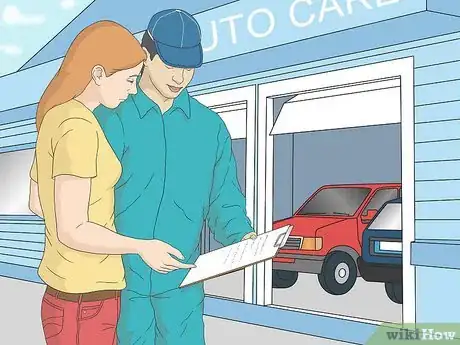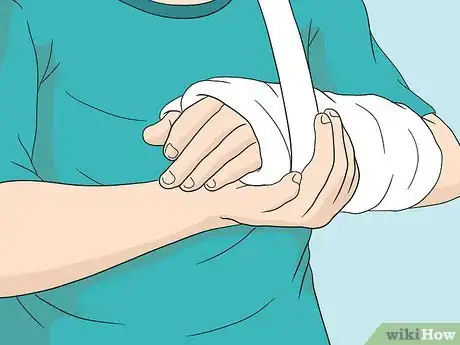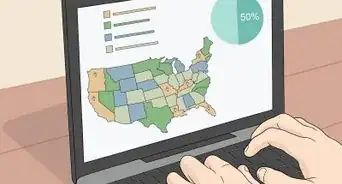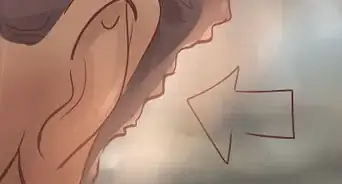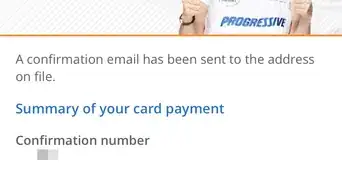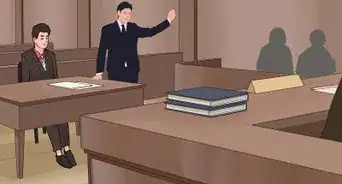This article was medically reviewed by Jonas DeMuro, MD. Dr. DeMuro is a board certified Pediatric Critical Care Surgeon in New York. He received his MD from Stony Brook University School of Medicine in 1996. He completed his fellowship in Surgical Critical Care at North Shore-Long Island Jewish Health System and was a previous American College of Surgeons (ACS) Fellow.
There are 8 references cited in this article, which can be found at the bottom of the page.
This article has been viewed 68,191 times.
If you have been in a car accident, your biggest worry after assessing your own health is determining how much compensation you will get to fix your car. Once the cars involved are moved out of the way of traffic, and any injuries are attended to, you can get started determining car accident damages using the following steps.
Steps
Directly After the Car Accident
-
1Address any medical concerns. If anyone involved in the accident sustained an injury, call an ambulance so that the person can get immediate medical attention. Make sure to get copies of the treatment records, and the costs involved to substantiate the claim — injuries and treatment will factor into your compensation.
-
2Take pictures of the damage done to your car due to the accident. Be sure to take photos of both the interior and exterior, from close-up and from far away, so that the insurance company can get a good idea of the extent of the destruction. Take pictures that show the location and license plate of each vehicle involved in the crash.[1]Advertisement
-
3Make note of any personal property inside the car that was damaged during the accident. This may include a CD player, laptop, purse, sunglasses, briefcase, infant car seat, cell phone, or any other item that you will have to repair or replace due to the accident. This also includes items that you were wearing during the accident; however, it does not include anything that may have been lost or stolen.[2]
-
4Write down a description of the car accident from your point of view. You will need to do this for the police report, but you should write this information down anyway if the police do not show up. It can be given to your insurance company to determine damages and fault.
- If the police do not show up at the scene, you should still file a police report at the police station as quickly as possible.[3]
-
5Do not admit guilt. Your only job at this time is to make notes about the situation, exchange contact information with the other driver, and cooperate with the police. Adjusters for the insurance companies involved will work later to identify which party is guilty. If you are guilty for the accident, you will file a "first-person" claim with your own insurer. If not, you will have to file a "third-party" claim with the other party's insurer. [4]
-
6Contact your insurance provider. Call your provider and report to them the basic details of the crash. This includes the vehicle on your policy that was involved, the driver of the vehicle at the time of the crash, the time and location of the crash, and a general description of the severity of the crash and damage. They will also need the insurance numbers and contact information for the other driver(s) in the crash and contact information for any witnesses.
- You may also be asked to provide a police report number, if there is one.
- You'll be provided with a claim numbers and phone number for a point of contact at the provider. Be sure to write these down.[5]
Assessing Damage
-
1Immediately fix damage that may worsen before your claim goes though. If your vehicle is still drivable, but has damage that may cause further damage to the vehicle if it is driven, your first step should be to get this damage taken care of. For example, if your sunroof doesn't close, you'll need to get that fixed or risk water damage. However, only get this fixed after contacting your insurance provider. Call them and report that your vehicle requires immediate repair. They will tell you what to do next. Typically, they will require you to take and send in photos of the damage and get a repair shop to validate that the repairs were indeed required.
- Keep all receipts of any repairs you have done during this time.
- Insurance providers are not responsible for post-accident, preventable damage, so make sure you get any issues like this repaired.[6]
-
2Get a repairs estimate. After taking care of the critical damage to your vehicle, you should get a repair shop, or several of them, to estimate the cost of repairing your vehicle. Ask the shop for a detailed, written estimate of what repairs will be done and the cost of performing each. This information will be critical later on in making sure you get enough from your insurance provider to cover repairs.[7]
-
3Call your insurance company as soon as possible to file a claim. Call the relevant insurance company within 24 hours of the accident. Let the representative know that you have pictures of the accident, as well as a list of damaged personal property. An adjuster will then contact you for more information. Prevent your account of the crash objectively, without guessing or speculating as to what happened. This information will be used to figure out who is at fault for the crash (and who is financially responsible for it).
- If you were at fault for the accident, you will have to call your own insurer. If you were not, call the insurer of the guilty party.[8]
- You may also have to make an appointment for a claims adjuster to look at your vehicle. Schedule this visit as soon as possible so that you can get your car accident damages determined quickly.
- Alternately, the insurance provider will have you visit an authorized repair shop to get a repairs estimate.[9]
-
4Wait for the adjusters' judgment. Adjusters for both your insurance company and that of the other person involved in the crash will be working to determine fault and the damages caused. If the crash was clearly one person's fault, that person's insurance will have to pay for the damage. If you are not at fault, you will need to file a claim with the other driver's insurance provider. If your claim is disputed, you will need to hire a lawyer to protect your interests. While they may pressure you into providing a recorded statement, it is not required, and can be used against you down the road, so avoid it at all costs.
- If the crash was your fault, your insurer will pay for damages to your vehicle and others involved in the crash. At this point, the adjuster will determine a payment for repairs to your vehicle after assessing damage and repair costs.[10]
Getting a Higher Payment
-
1Dispute the adjuster's estimate. The adjuster's job is to save the company money by offering the lowest amount you will take. They also expect you to ask for more than their initial offer, so be prepared to negotiate with them up to the limit that they are authorized to provide to you. Try using your repair shop estimates to work up the amount of your claim. In addition, you can incorporate additional sourcing and labor costs if your car is particularly old, rare, or otherwise expensive to repair.[11]
-
2Know the limits of your policy, as well as the maximum amount that your state allows to be paid in car accident damages. Each state has a different set of laws that specify how much may be paid out in car insurance claims. This is especially true with regards to damages that extend beyond car damage (like medical bill and emotional distress).[12]
- Realize that you cannot get a payment for repairs equal to or greater than about half of the value of your car. This is because anything over this value is considered a total loss. At this point, the insurer will not repair the car, but will provide you with an amount equal to the market value of your car before the accident.
- If you want to keep your car, make sure not to negotiate a payment higher than this amount.
- The exact percentage varies between insurers, but marking a payment of 50 percent of the car's value or greater as a total loss is common.[13]
-
3Check for diminished value coverage. Diminished value coverage provides you with an additional payment for the loss of value your car will experience after being in a car accident. Each insurance agency figures out this value differently, but you can estimate your car's loss in value to see how much you might get. See how to calculate diminished value for more information.[14]
-
4Be aware that you can get compensated for more than just damage to your car and medical bills. You may also receive money for loss of income, emotional loss, or permanent physical injuries. Keep track of the days that you have taken off work due to your injuries or doctor appointments related to the accident. Keep track of your medical bills, collecting doctor notes and itemized bills when possible.
- Obtaining payment for medical bills directly after the accident and loss of income from an insurer is fairly easy, as these can easily be quantified; however, if you are going to seek ongoing treatment or general damages payments (like emotional distress), you may want to retain an attorney.[15]
- General damages are usually calculated using a multiple based on the severity of the injuries. Your medical bills are then multiplied by this number to arrive at a settlement amount. For example, a relatively non-serious injury might have a multiple of two, whereas very serious injuries may have one as high as 10.[16]
-
5Hire a lawyer if you do not think the determined amount is fair, as long as you have evidence to back up your case. You can also hire an attorney if you are not at fault for the accident and the other person's insurance doesn't cover your medical costs or refuses to pay them. Personal injury attorney specialize in this type of work, so look for an experienced one in your area.[17]
- You have other rights that you can exercise without hiring an attorney. For example, you may be able to have an independent appraisal performed on the damages. Or, you can try contacting your state's insurance department to file a claim against the insurer if you do not believe they are negotiating in good faith.[18]
References
- ↑ http://www.dmv.org/insurance/auto-accident-payment-recovery.php
- ↑ http://www.allenandallen.com/what-about-my-car.html
- ↑ https://wallethub.com/edu/car-insurance-claims/12882/
- ↑ http://injury.findlaw.com/accident-injury-law/insurance-claims-after-an-accident-the-basics.html
- ↑ https://wallethub.com/edu/car-insurance-claims/12882/
- ↑ https://wallethub.com/edu/car-insurance-claims/12882/
- ↑ http://www.chicagolawyer.com/resource-center/how-do-claims-adjusters-determine-vehicle-damages/
- ↑ http://injury.findlaw.com/accident-injury-law/insurance-claims-after-an-accident-the-basics.html
- ↑ https://wallethub.com/edu/car-insurance-claims/12882/
- ↑ http://www.dmv.org/insurance/auto-accident-payment-recovery.php
- ↑ http://www.chicagolawyer.com/resource-center/how-do-claims-adjusters-determine-vehicle-damages/
- ↑ http://www.autos.com/auto-insurance/calculate-general-damages-with-these-6-steps
- ↑ http://www.chicagolawyer.com/resource-center/how-do-claims-adjusters-determine-vehicle-damages/
- ↑ http://www.dmv.org/insurance/auto-accident-payment-recovery.php
- ↑ https://www.freeadvice.com/legal/what-is-your-car-accident-injury-claim-worth/
- ↑ http://injury.findlaw.com/accident-injury-law/insurance-claims-after-an-accident-the-basics.html
- ↑ http://www.dmv.org/insurance/auto-accident-payment-recovery.php
- ↑ https://wallethub.com/edu/car-insurance-claims/12882/
- ↑ https://myhoustoninjuryattorneys.com/car-accidents/car-accident-settlement-negotiation-tips/







